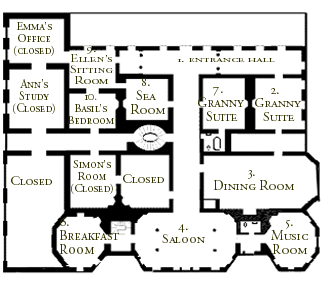| Stoney Grove Prepared by Emma Knytleigh |
|||||||||||||
|
The Architecture William Blake commissioned architect Culpability Heath to build the house in classic Palladian style and design the surrounding landscape. Sadly, William survived only two years after the house was completed. Remarkably, the house remained within the family line until the passing of its last member in 1995. It stood empty until purchased by Ann Simmons and Simon Tinsley in the spring of 1999. Research into the changes to the house and furnishings over time is currently underway, and some restoration has been accomplished. It is clear that the house has been extensively altered over time. Blake’s widow Fanny introduced the French neo-classical style at Stoney Grove after her husband’s death, altering the somewhat old-fashioned character of the original. Between 1870 and 1875 her great-grandson, William Blake Hall, added a west wing, thereby upsetting the structure's Palladian symmetry. During the same period of prosperity, he constructed a greenhouse and stables on the property. Later still, the house underwent modernisation with the installation of plumbing, electricity, and central heating. Owners throughout the history of the house have altered the size and function of individual rooms, molding the building to suit their own needs and tastes. Ongoing research and restoration are beginning to re-establish the grandeur of the old
estate. The House Today
The House in the First Half of the Twentieth Century 1. The Entrance Hall. This grand entrance, in neo-classical style built on the Ionic order, was created during the extensive remodeling of the house under the direction of William Blake Hall in the 1870s. In the original house, this space was divided and made up the northern ends of what are currently Rooms 2, 7 and 8. Hall purchased the 18th century imitation-marble columns and crystal chandeliers from nearby Exley Manor House when it was largely destroyed by fire in 1871, and incorporated them into a convincing re-creation of a grand 18th-century entrance hall. Under his ownership, the walls were covered with hunting trophy heads, and the family referred to this space as the "Jungle Room." Following its death, the hall was converted to the more elegant style that it retains today. 2. Granny Suite, east. This room, originally a library, was converted into a sitting room for owner Elizabeth Kent Hall's elderly mother, who came to live at the property in the 1920s. 3. Dining Room. Designed on the Corinthian order, with a frieze of alternating ox skulls and swags copied from the ancient Temple of Vesta at Tivoli, the room has apparently always functioned as it does today. The bow window on the east wall was added by Miss Ellen Hall (pre-1973). 4. Saloon. 5. Music Room. 6. Breakfast Room. 7. Granny Suite, west. Originally a study or business room, this space was converted in the 1920s as part of a "Granny Suite" of bedroom, sitting room and bath for Montgomery Hall's grandmother. It served as her bedroom and years later, as Monty's own following the death of his sister Ellen in 1973. 8. Ellen Hope Hall's bedroom (c. 1939-1973), known as the "Sea Room." Designed in the Ionic order (traditionally seen as the feminine order), its decoration is loosely based on the Temple of Concord in the Roman Forum. 9. Ellen's Sitting Room. Part of her private suite of rooms, it was here that Ellen penned her well-known Robins, Sparrows and Barn Owls, a Guide to West Sussex Walks in 1953, and here that she tended to her correspondence. 10. Basil's Blake Hall's bedroom (c.1939-1962).
|
||||||||||||

